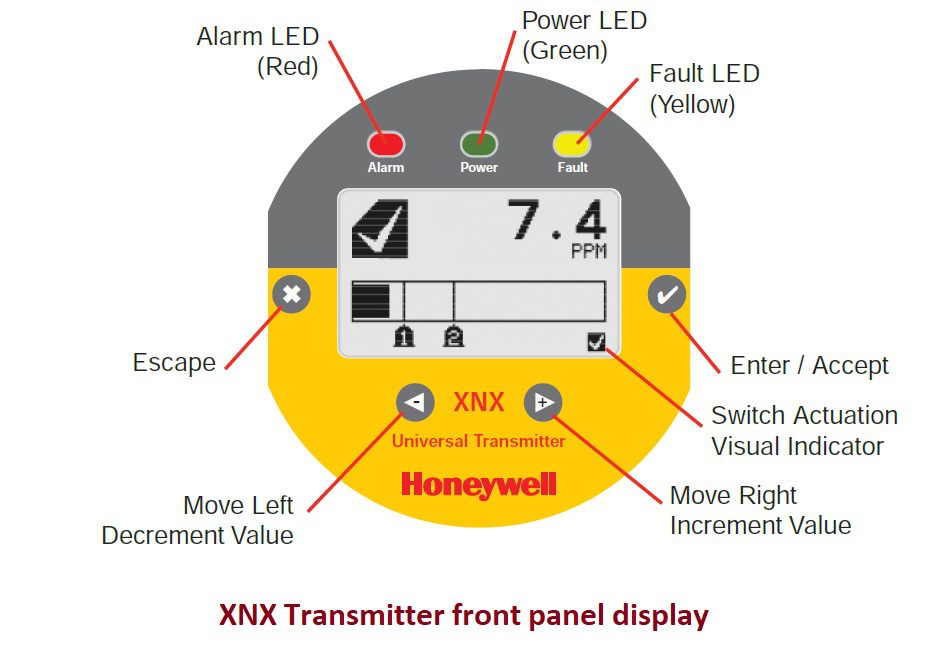Table of Contents
Introduction
XNX Honeywell chlorine gas detector is basically a universal transmitter along with chlorine sensing electrochemical (EC) sensor to detect concentration of chlorine gas in ambient. There are 2 sensor cartridges available with XNX Honeywell universal transmitter. XNX series belongs to Honeywell and used for air quality measurement or comprehensive gas detection system and designed to operate in hazardous locations. It utilizes multiple sensor technologies, catalytic bead, electrochemical (EC), or infrared (IR) to detect toxic gases, flammable gases, and oxygen depletion gas hazards. Each type of sensing technology has a dedicated personality board. For XNX Honeywell chlorine gas detector, electrochemical (EC) technology is used. EC sensors measure toxic gases in low concentrations. A diagram for XNX universal detector application with EC sensor is shown below-

Honeywell XNX transmitter-
Honeywell XNX transmitter is a universal transmitter for air quality measurement or gas concentration detection. For sensing application various possible configuration is shown in figure-





They are having a PCB circuit and a display unit enclosed in a stainless steel or aluminum housing. Here PCB for various sensor technologies is different interface personality board as given below-
- mV personality board
- EC personality board
- IR personality board
“mV personality board” utilizes Catalytic bead technology. And its sensor responds to a wide variety of combustibles so are typically used for flammable gas detection.
“EC personality board” utilizes electrochemical (EC) technology and its sensor measure toxic gases in low concentrations.
“IR personality board” utilizes Infrared technology and IR sensors optically absorb gases that fall into the infrared spectrum.





Honeywell XNX transmitter satisfies Class 1/Class 2 intrinsically safe, explosion-proof requirements in oil refineries, chemical industries, wastewater industries etc. For chlorine gas detection, XNX EC sensor is used with EC personality board in XNX universal transmitter. Range of Chlorine gas sensing is up to 5 ppm for low concentration and 20 ppm for high concentration.
Installation of Honeywell XNX transmitter
Installation of Honeywell XNX transmitter can be done in any of the arrangement as shown below-





Board Connection in Honeywell XNX transmitter–
Honeywell XNX transmitter requires input voltage to be maintained at (18 to 32) VDC for proper operation. The power requirements for different XNX transmitter configurations are-
- XNX EC (Toxic): 6.2 watts
- XNX mV (Catalytic): 6.5 watts
- XNX IR with Searchpoint Optima Plus: 9.7 watts
- XNX IR with Searchline Excel: 13.2 watts
The connection diagram with jumper settings for Honeywell XNX transmitter for each board configurations is shown below-










Wiring diagram of XNX Honeywell chlorine gas detector-
Honeywell XNX transmitter follow 3 wire or 4 wire connection requirement to use in stanadard (4-20) mA . There are 3 possible mode of operation “Source mode, sink mode and isolated mode”. A wiring diagram for all 3 modes is shown below-





Current in measuring loop also defines the various description which helps in troubleshooting. Different mA states are shown below-





Display unit
A detailed description about front display unit of Honeywell XNX transmitter is shown below-





Details of screen status and LED status for normal operation, warning, fault, alarm states is shown below-





Calibration of XNX Honeywell chlorine gas detector-
There are two levels that control access based upon the security level of the user and The pass codes for both levels are set at “0000” from the factory. Before initial calibration allow the detector to stabilize for 30 minutes after applying power. When in zero and span calibration mode the current output from the detector is inhibited (default 3mA) to avoid false alarms. It is recommended for most sticky gases (i.e.: HCl, Chlorine) the tubing should be PTFE with short pieces of rubber tube to make the final connection due to the inflexibility of PTFE. Now to perform calibration, apply zero calibration gas, and after stabilization of reading perform zero calibration. And apply span calibration gas, and after stabilization of reading perform span calibration. A sequence of steps in screen is shown below-





Typical life of a toxic gas sensor is dependent on the application, frequency and amount of gas exposure. Under normal conditions (3 month visual inspection and 6 month test/ re-calibration) the toxic sensor has an expected life equal to or greater than the lifetime as listed below-
- 18 months for Chlorine and Chlorine Dioxide sensors.
- 12 months for Ammonia and Hydrogen Fluoride sensors.
- 24 months for Oxygen and other toxic sensors.
Available gas detection-
A list of available gas detection using Honeywell XNX transmitter for EC sensor along with their sensor cartridge no., measuring range, cal gas range is shown below-





A list of available gas detection using Honeywell XNX transmitter for mV sensor, IR sensor along with their sensor cartridge no., measuring range, cal gas range is shown below-





Click here to read more about Honeywell XNX
Click here to download Honeywell XNX Quick Start manual in pdf